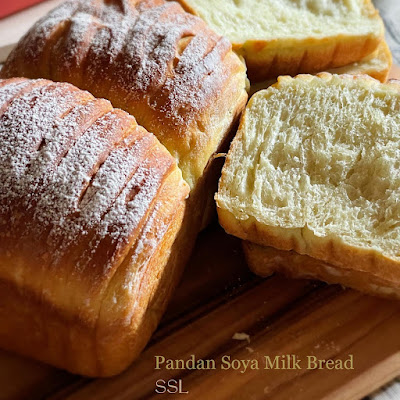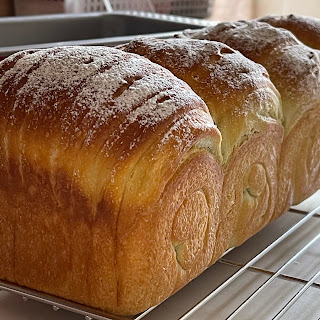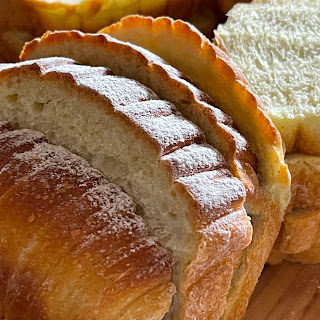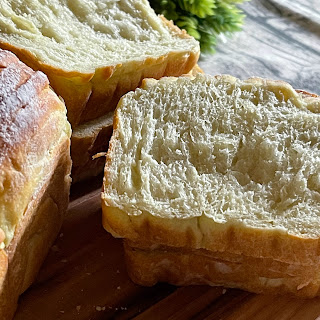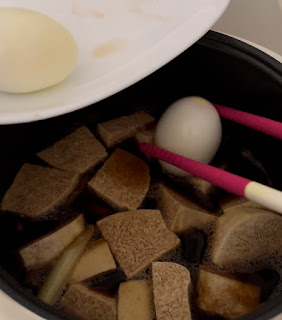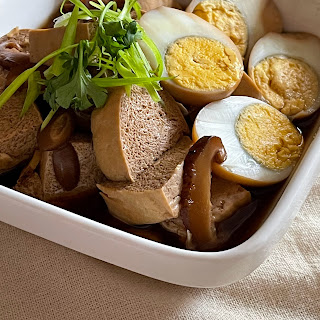A great flavour pandan bread added with Oats and Quinoa Soya Milk and Sweet Stiff Levain. The only sad thing about this bread was I could not cut a neat thread pattern to the crust. Hope I can update with a more decent photo of the crust in my subsequent attempts 😉💪💪💪
Yield: 4 mini loaves in one long pan
Pan size: 26x9x7 cm Ikea long pan
Raw dough weight: 673g
Baking temperature: Preheat oven to 190℃, middle rack, bake at 180℃ for 15 minutes, reduce to 170℃ for 15 minutes, turn off oven and continue to bake for 3 minutes.
My Teka HLB840 oven has a Temperature Surround feature which allows the bread to baked at a shorter duration.
Sweet Stiff Levain (SSL)
Ingredients
37g cool boiled water
15g raw sugar
20g natural yeast, 100% hydration*
80g unbleached bread flour
* 20g natural yeast can be replaced by 10g bread flour + 10g water + 1/8 tsp instant dry yeast
Let the sweet stiff levain stands in room temperature for about 6 to 8 hours, or triple in volume, before adding to dough.
Pandan Milk Bread
Ingredient
A
220g bread flour
25g superfine wholegrain flour/plain flour
40g raw sugar
5g milk powder
1g instant dry yeast
B
150~155g sweet stiff levain
C
130g Oats & Quinoa soya milk/low fat milk
D
30g fresh pandan paste #
20g beaten egg
20g grapeseed oil/mild flavour vegetable oil ^
E
30g water, cold (to be added depending on dough condition)
F
4g low-sodium fine salt
# Blend 20g pandan leaves with 50g water into very fine texture. Collect 30g for use, and keep the balance in fridge.
^ avoid adding butter and coconut oil to pandan bread. To me, these two oils will give the bread a rancid smell after baking.
Directions
Knead the dough following your preferred method till reaching window pane.
1. Mix Ingredient A in a big mixing bowl. Tear Ingredient B into smaller pieces and add to Ingredient A mixture.
Store the dough in the fridge for about 12 to 16 hours, or overnight to undergo cold fermentation.
My fridge temperature is about 4℃.
8. Place the shaped dough into the prepared bread pan brushed with a coat of homemade non-stick baking spread, or butter. Cover with a piece of tea cloth, and let them proof for about 60 minutes, or when dough top almost reaching the brim of the pan.
10. Invert out the bread immediately after leaving the oven. Cool over a wire rack.
 |
| Beginning of second proofing |
 |
| End of second proofing |
9. Preheat oven to 190℃. Dust some bread flour over the top of the dough. Bake at 180℃ for 15 minutes, reduce to 170℃ for 10~15 minutes, turn off oven and continue to bake for 3~5 minutes.
My Teka HLB840 oven has a Temperature Surround feature which allows the bread to baked at a shorter duration.
11. Cut the bread after it has completely cool down 😍 Enjoy 😋
